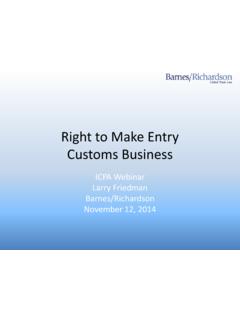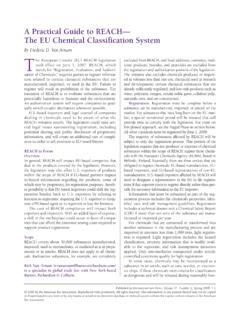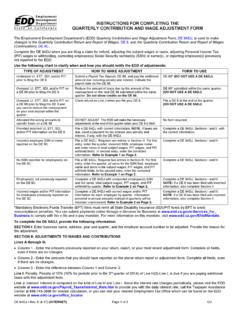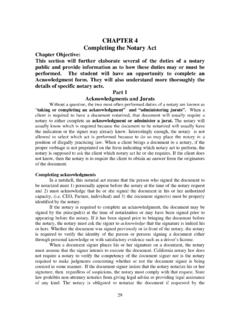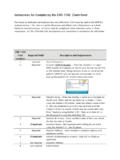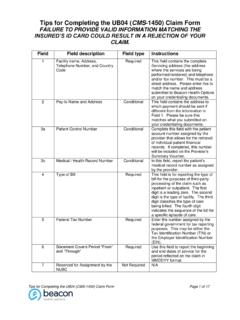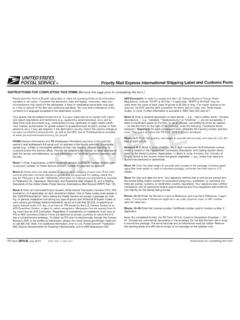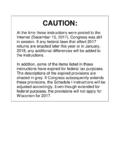Transcription of A Guide for Reviewing and Completing NAFTA …
1 1 A Guide for Reviewing and Completing NAFTA Certificates of Origin By Lawrence M. Friedman Barnes, Richardson & Colburn (312) 565-2000, Generally: The form must be complete and accurate. The NAFTA CO should be provided by the exporter to the importer to support the importer s claim for duty-free entry. The form can also be provided by the producer for use by the exporter. Field 1: Exporter Name and Address This field should contain the name, address and tax identifier of the party exporting or selling the merchandise. In purely domestic transactions, it is appropriate to put the name, address and tax identifier of the seller in this field.
2 It is also permissible, in domestic transactions, to change the word Exporter to Seller. Some domestic producers prefer to place N/A or something similar in the field and provide their identifying information only in Field 3. Field 2: Blanket Period If the CO covers multiple shipments of identical goods, include a period covered by the CO. The period may be no more than one year. Thus, a certificate covering 01/01/2013 to 01/01/2014 is not correct. The blanket period may begin before the signature date in Field 11. If the CO covers only a single shipment, there is no blanket period to be recorded in this field.
3 Field 3: Producer Name and Address Provide the name, address and tax identifier of the producer. If the exporter is the producer, state Same. If the producer is unknown, state Unknown. If the person Completing the CO does not wish to disclose the producer, it is acceptable to state Available to Customs Upon Request. Note that there must be agreement between Field 3 and Field 8. 2 Field 4: Importer Name and Address State the name, address and tax identifier of the importer if known. If the importer is not known, state Unknown. If the CO will be provided by the exporter to multiple importers, as is usually the case with blanket COs, state Various.
4 In purely domestic transactions, it is appropriate to put the name, address and tax identifier of the buyer in this filed. It is also permissible, in domestic transactions, to change the word Importer to Buyer. Field 5: Description of the Goods This field should contain a clear description of the goods. The description must be detailed enough to permit the tariff classification of the merchandise and to identify that the CO covers the merchandise included in a shipment. For a blanket CO, a part number and description can usually accomplish this. For single shipment COs, include the commercial invoice number, airway bill number or other unique identifier.
5 Field 6: HS Tariff Classification In most cases, this field requires only the six-digit tariff classification of the merchandise. However, some rules of origin (see HTSUS General Note 12(t)) operate at the eight-digit level. In those cases, provide or confirm all eight digits. The eight-digit code must be the code appropriate for the country of importation. Therefore, you may need to place multiple line items on the CO for the same goods (for the US, Mexico and Canada eight-digit codes). For COs received from suppliers, review the classification to determine that it is correct. An incorrect classification may result in the incorrect rule of origin being applied.
6 This may invalidate the CO. Do not rely on supplier COs for the classification of your imports. As an importer, you have an independent responsibility to classify merchandise correctly. Field 7: Preference Criterion Purchasing goods from a North American supplier does not ensure that they are originating. The four most likely codes that should appear in this field: A, B, C, or D. In some cases, suppliers may identify non-originating goods on the CO and include N/A, X, or something similar in this field. That is not the best practice as it leads to confusion especially if the origin information in Field 10 identifies a NAFTA party as the country of origin.
7 Certain data processing equipment may be certified with the Criterion E and certain agricultural products with Criterion F. Preference criterion A signifies that the good was wholly obtained or produced in North America. That means that no non-North American materials were used in the production of the good. Preference criterion A applies to raw and natural materials such as minerals and crops and to waste and scrap generated in North America that is only good for the recovery of the raw 3 material. Preference Criterion A almost never applies to industrial goods and should be questioned. Preference criterion B is the most commonly correct criterion.
8 This rule is for goods that satisfy the applicable NAFTA rule of origin as a result of production in North America. The specific rules are found in General Note 12(t) of the Harmonized Tariff Schedule of the United States. Preference criterion C indicates that no non-originating materials were used in the production of the good. This rule differs from preference criterion A in that some components may be originating because through processing they satisfied the applicable rule of origin and have been certified. For example, if a good has three components, all of which have been certified as NAFTA originating based on preference criterion B by the supplier, the finished good qualifies as NAFTA originating based on preference criterion C.
9 Preference criterion D should only be used for goods that are unassembled, disassembled, incomplete, or are classified in the same HS provision as their parts. In these cases, tariff shifts are impossible and the merchandise will qualify if it satisfies the applicable regional value content requirements. Field 8: Producer If the producer listed in Field 3 is the certifier (as shown in Field 11), Field 8 should contain the word Yes. If the certifier is not the producer, the certifier ( , most often the exporter) must state the basis of its knowledge that the goods qualify. There are three acceptable bases for certification, presented in descending order of reliability: No(3) the certificate is based on a signed CO voluntarily provided to the exporter by the producer No(2) the certificate is based on the producer s written representation that the goods are originating.
10 No(1) the certificate is based only on the certifier s knowledge that the goods are originating Note that the first two options specify that the CO or other written statement come from the producer. Any other backup, including a document provided by a distributor should be questioned and due diligence undertaken to confirm. If you are satisfied as to origin, the proper code would be No(1). Field 9: Net Cost If the goods originate by virtue of a net cost RVC calculation, this field should contain the code 4 NC. In all other cases, it should contain NO. Incoming COs should be checked to confirm that if NC was used, it is permitted by the applicable rule of origin (rather than having a tariff-shift only rule).
